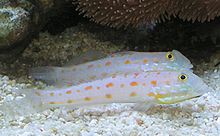| Valenciennea puellaris | |
|---|---|

| |
|
Scientific classification
| |
| Domain: | Eukaryota |
| Kingdom: | Animalia |
| Phylum: | Chordata |
| Class: | Actinopterygii |
| Order: | Gobiiformes |
| Family: | Gobiidae |
| Genus: | Valenciennea |
| Species: | V. puellaris
|
| Binomial name | |
| Valenciennea puellaris (
Tomiyama, 1956)
| |
| Synonyms | |
| |
Valenciennea puellaris, the Orange-spotted sleeper-goby, Orange-dashed goby, or Maiden goby, Diamond Watchman goby, is a species of goby native to the Indian Ocean and the western Pacific Ocean. It inhabits lagoons and outer reefs where it occurs on sandy substrates with larger pieces of rubble to burrow under. It can reach a length of 20 centimetres (7.9 in) SL. It is a prevalent fish in the aquarium hobby. Its main diet is composed of zoo plankton and dead fish or insects.
References
- ^ Larson, H. (2016). "Valenciennea puellaris". The IUCN Red List of Threatened Species. 2016: e.T193068A2190891. doi: 10.2305/IUCN.UK.2016-3.RLTS.T193068A2190891.en.
External links
- Photos of Valenciennea puellaris on Sealife Collection
| Valenciennea puellaris | |
|---|---|

| |
|
Scientific classification
| |
| Domain: | Eukaryota |
| Kingdom: | Animalia |
| Phylum: | Chordata |
| Class: | Actinopterygii |
| Order: | Gobiiformes |
| Family: | Gobiidae |
| Genus: | Valenciennea |
| Species: | V. puellaris
|
| Binomial name | |
| Valenciennea puellaris (
Tomiyama, 1956)
| |
| Synonyms | |
| |
Valenciennea puellaris, the Orange-spotted sleeper-goby, Orange-dashed goby, or Maiden goby, Diamond Watchman goby, is a species of goby native to the Indian Ocean and the western Pacific Ocean. It inhabits lagoons and outer reefs where it occurs on sandy substrates with larger pieces of rubble to burrow under. It can reach a length of 20 centimetres (7.9 in) SL. It is a prevalent fish in the aquarium hobby. Its main diet is composed of zoo plankton and dead fish or insects.
References
- ^ Larson, H. (2016). "Valenciennea puellaris". The IUCN Red List of Threatened Species. 2016: e.T193068A2190891. doi: 10.2305/IUCN.UK.2016-3.RLTS.T193068A2190891.en.
External links
- Photos of Valenciennea puellaris on Sealife Collection
